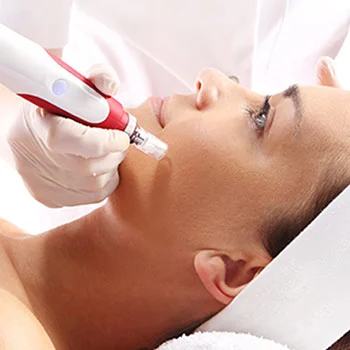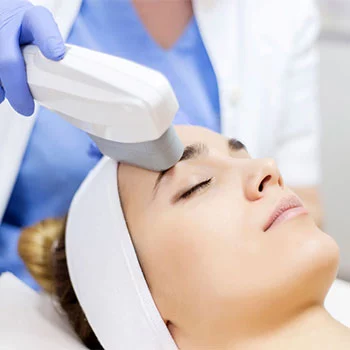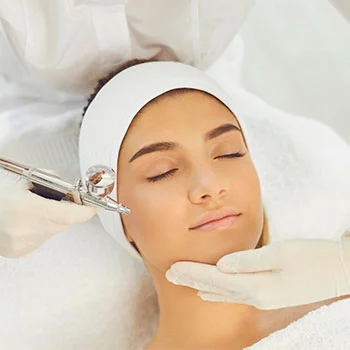What is carboxytherapy?
Carboxytherapy is a rejuvenation method that originated in the 1930s in French spas. It involves injecting controlled amounts of carbon dioxide gas under high pressure into the subcutaneous tissue, which stimulates blood circulation and collagen production, enhancing skin tone, elasticity, firmness, and texture, as well as reducing subcutaneous fat deposits. The result is a plumped-up, firmer skin with reduced cellulite dimpling.
How carboxytherapy works
The idea behind carboxytherapy is that when additional carbon dioxide is injected beneath the skin, the body thinks that there is a lack of oxygen and tries to fix the problem by increasing the blood supply to the part of the body that receives the CO2. This increases the oxygen supply to the tissues, which boosts your metabolism and production of collagen and elastin, leading to an overall improvement in the appearance of the skin and fat reduction.
Cellulite, stretch marks, and dark under-eye bags are all caused by poor blood circulation. Carbon dioxide is emitted by the body's cells as a waste product. The oxygen you inhale is carried to tissues by red blood cells, subsequently picking up carbon dioxide. The lungs eventually exhale the carbon dioxide.
By injecting carbon dioxide into a specific region, a physician can boost blood circulation and cause red blood cells to rush to the spot. This improves metabolism and skin elasticity and changes the skin color to a healthy glow in the case of dark circles under the eyes.
What carboxytherapy is used for
Carboxytherapy is typically done to treat stretch marks, cellulite, and dark under-eye circles.
Stretch Marks: Stretch marks are scar-like marks that can be seen on your body after a sudden weight gain or pregnancy that causes the skin to stretch dramatically. Carboxytherapy stimulates the production of new collagen, thickening the skin and improving stretch marks.
Cellulite: Cellulite is the dimpling of the skin due to subcutaneous fat stores. Carbon dioxide gas injected into fat cells can cause them to burst and be expelled from the body. Several studies have shown that using carboxytherapy to treat cellulite is both safe and effective but more studies are needed to better understand the effectiveness of carboxytherapy for cellulite reduction.
Under-eye Circles: Poor circulation, which causes vascular pooling, is the most common cause of dark circles beneath the eyes. The bluish pooling is reduced and replaced with a blush tone when CO2 gas is injected into the lower eyelids.
Alopecia: Carboxytherapy can also be used to treat alopecia (hair loss) caused by poor blood flow. Carbon dioxide injection can dilate blood vessels and raise the number of red blood cells supplied to the scalp, stimulating hair growth.
After Microneedling: Carboxytherapy can also be used after microneedling to stimulate collagen production, improve skin tone and texture, and reduce acne scars.
Carboxytherapy may sometimes be used to treat scars, acute arthritis, erectile dysfunction, and Raynaud's phenomenon.
What areas can be treated with carboxytherapy?
Areas that can be treated with carboxytherapy include:
- Face and décolletage
- Under eyes
- Double chin
- Arms
- Breast
- Legs, buttocks, and abdomen.
How it's done
Carboxytherapy is a minor procedure and doesn’t require much preparation. Your doctor may give you some instructions to follow before the procedure. It is recommended to avoid exercise, alcohol, and sunlight for 24 hours before your appointment. Be sure to inform your surgeon in case you have any allergies.
A carboxytherapy treatment takes 15 to 30 minutes, and you will be able to resume your normal activities immediately after the treatment.
How long do carboxytherapy results last?
The results of carboxytherapy last from 2 months to a few years depending on your lifestyle. The average longevity of the results is 5-6 months, after which the effect of the treatment will start to wear off. It is advised to avoid smoking and drinking alcoholic beverages and drink a lot of water after your carboxytherapy to maximize its effects.
The effects are visible immediately after a few sessions but you should get the treatment repeated once or twice a week until you no longer see any improvement. Each time you have a carboxytherapy treatment, it gives your body an additional boost of oxygen and nutrients, allowing the results to last longer. After that, you need to wait at least 3 months before considering a new treatment course.
Continued use of carboxytherapy reduces the number of treatments required, so it is an investment in both time and money that will pay off in the long run. The effects are visible within weeks after each session, and it's recommended to continue for a minimum of 3 months, although many people wish to extend the treatment for longer.
Is carboxytherapy safe?
The injected gas is a natural derivative of CO2, which means your body can dissolve it without issues. For decades, carboxytherapy has been used safely in tissue oxygenation to increase oxygen levels when treating chronic wounds that do not respond well to conventional treatments. It has gained much attention in the beauty industry in recent years and has been used with few side effects.
In addition, CO2 has no known interference with the function of the heart and lungs. Therefore it does not cause hypertension or any cardiac problems due to its widespread use in medicine and at home (in food and water).
Studies have shown that patients receiving carbon dioxide injections may suffer from minimal side effects such as temporary headaches and nausea, which will go away within a short time after treatment.
What is carboxytherapy recovery like?
Carboxytherapy is a simple outpatient procedure after which you can go home immediately. It is advisable not to do strenuous exercise for 24 hours after the procedure. In particular, avoid heat and sun exposure, as you will be more sensitive to these elements after the treatment. You should also drink plenty of water before and after the treatment and take extra care of your skin and nails.
You should also avoid any products that may dry the area, like alcohol, astringent and harsh detergents.
How much does carboxytherapy cost?
The cost of carboxytherapy depends on a series of factors, including the location of the clinic, specialist’s expertise, treatment area, etc. But on average, a session of carboxytherapy costs $100- $250. So with a course of treatment including 10 sessions, you have to pay $1000-$2500.
Takeaway
Carboxytherapy is a safe and painless treatment that can be performed as an outpatient procedure at your dermatologist's office to treat skin conditions like cellulite, stretch marks, dark circles under the eyes, and hair loss. After the skin is cleaned and numbed with a local anesthetic, the gas is injected into specific spots on the body using micro-needles. When performing carboxytherapy on the face, you may experience some redness or mild bruising. This irritation subsides after a few hours.
You can resume your routine activities immediately after the procedure. You should not experience any significant side effects, but you may experience mild bruising or redness around the treatment area that subsides over time.
FAQs
Can I lose fat with carboxytherapy?
Carboxytherapy can reduce local fat deposits but is not meant for those who want to shed a lot of weight.
Who can have carboxytherapy?
Carboxytherapy is a treatment for women and men over 18 who wish to reduce the appearance of cellulite, stretch marks, under-eye circles, and some other problems (mentioned above).
How many sessions of carboxytherapy do I need?
You may get your desired result with 3-12 sessions depending on the area being treated and the improvement you expect, but most people need more than 10 sessions for optimal results.




